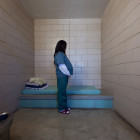

An 11-year-old denied making a threat and was allowed to return to school. Tennessee police arrested him anyway.
|
In late September, Torri was driving down the highway with her 11-year-old son Junior in the back seat when her phone started ringing.
It was the Hamilton County Sheriff’s deputy who worked at Junior’s middle school in Chattanooga, Tennessee. Deputy Arthur Richardson asked Torri where she was. She told him she was on the way to a family birthday dinner at LongHorn Steakhouse.
“He said, ‘Is Junior with you?’” Torri recalled.
Earlier that day, Junior had been accused by other students of making a threat against the school. When Torri had come to pick him up, she’d spoken with Richardson and with administrators, who’d told her he was allowed to return to class the next day. The principal had said she would carry out an investigation then. ProPublica and WPLN are using a nickname for Junior and not including Torri’s last name at the family’s request, to prevent him from being identifiable.
When Richardson called her in the car, Torri immediately felt uneasy. He didn’t say much before hanging up, and she thought about turning around to go home. But she kept driving. When they walked into the restaurant, Torri watched as Junior happily greeted his family.
Soon her phone rang again. It was the deputy. He said he was outside in the strip mall’s parking lot and needed to talk to Junior. Torri called Junior’s stepdad, Kevin Boyer, for extra support, putting him on speaker as she went outside to talk to Richardson. She left Junior with the family, wanting to protect her son for as long as she could ...

Longtime Non-profit is Casualty of Economic Conditions, Funding Trends
|
After nearly 35 years of operation, Public/Private Ventures (PPV) will close by the end of July. The decision came after the Board of Directors concluded that, given current funding trends and economic conditions, PPV operations were not sustainable despite staff cuts and support from numerous private funders. “We’ve been monitoring our finances for well over a year with the prospect that we might have to plan for a wind-down if we didn’t secure the kind of dedicated funding PPV has enjoyed in the past,” said PPV President Nadya Shmavonian. “But [that foresight] will allow us to do this in as responsible a manner as possible, with a real priority on moving the work and projects to a new homes.”
PPV, a national non-profit with offices in New York City, Philadelphia and Oakland, has worked to improve the effectiveness of social programs around the country, with a particular focus on young people from high-poverty communities. The organization has about 40 active projects, and has already began the work of “winding down” -- finding suitable organizations to continue the programs, on a project-by-project basis.

Frequent Marijuana Use Among Teens is Up
|
Heavy marijuana use among teens has increased drastically in recent years, with nearly one in 10 sparking up 20 times or more each month, according to a new survey of young Americans released this morning. The findings represent nearly an 80 percent increase in past-month heavy marijuana use among high school aged youth since 2008. Overall, the rate of marijuana use among teens has increased. Past month marijuana users, or teens that have used marijuana in the month prior to the survey, increased 42 percent, to 27 percent of teens, compared to 2008 findings. Past-year and lifetime use also increased, but not as drastically, at 26 percent and 21 percent respectively.

Runaway Youth Helped Using 10-Question Tool
|
Experts estimate about 2 million kids run away from home each year putting them at greater risk of physical or sexual abuse, homelessness, drug addiction and physical and mental health problems. Many are in need of medical care or other services. To ensure runaways get the help they need, police in St. Paul, Minn. who encounter runaways are using a short, 10-question screening tool to assess the runaway’s safety and whether they have been victimized while they’ve been away from home. Medical professionals and researchers in Minnesota developed the 10-Question Tool with assistance from local police.

Bart Lubow on the Juvenile Detention Alternative Initiative (JDAI)
|
Bart Lubow, who has been working for more than 20 years to reduce the number of youth being sent to detention centers, told a gathering of 700 attendees at the Juvenile Detention Alternatives Initiative (JDAI) conference in Houston last week that now, “may prove to be a unique moment in juvenile justice history, a time when, as a nation, we shed some of the system’s worst baggage - including our unnecessary and often inappropriate reliance on secure confinement” of youth. Center for Sustainable Journalism Executive Director Leonard Witt, publisher of the Juvenile Justice Information Exchange and Youth Today, caught up with Lubow to get his take on JDAI initiatives that have expanded to 38 states across the country and become the most widely replicated juvenile justice system reform project in the nation. Learn more about Bart Lubow, Director of Juvenile Justice Strategy for the Annie E. Casey Foundation.

Families of Incarcerated Youth Demand Say in ‘Dysfunctional’ System
|
Jeannette Bocanegra, a community organizer from New York City, told a gathering of juvenile justice system practitioners and advocates in Houston last week that as a mom with a child who was incarcerated, “This system made me feel like I was a dysfunctional parent, a bad parent … without realizing I raised six other children who never went into the system.”
Now she and other members of Justice for Families, an advocacy group, are out to prove that, in her words, “We are not dysfunctional … the system is dysfunctional.”
Liane Rozzell, another parent on the panel, said afterwards, “We don’t have 24-hour remote control over our children.”
During the panel discussion, Rozzell said when her son was first put into detention she thought it might be a good thing, it would teach him a lesson. But she did not realize how negatively he would be affected by the experience. She also recalled being in a meeting where a teacher from a correctional institution off handedly mentioned sending kids to “an inherently violent place like a juvenile correctional center.”
After hearing that phrase, Rozzell said, “I was just stunned that we can just casually talk about sending our children to an inherently violent place.”
In June, Justice for Families will be releasing an in-depth report, underwritten by the Annie E. Casey Foundation. The report includes results of a survey of 1,000 family members who have had children incarcerated and examines how families of the incarcerated are portrayed by the media. Justice for Families co-director Grace Bauer says family involvement and networking is necessary because, “No one knows what it is like to struggle with a child in the system better than another parent.”
However, according to Bauer, early findings from the report reveal, “Families are not consulted.




